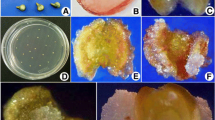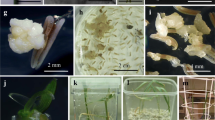Abstract
Anthers of Morus indica L., with microspores at the uninucleate stage were cultured; and the influence of temperature and kinetin pretreatment on induction of androgenic calluses was examined. The effects of various pretreatments revealed that 24 h cold pretreatment increased the percentage of cultures inducing callus. First microspore division was observed after 16 to 20 days of culture. Th anthers split and developed embryogenic calluses on MB medium supplemented with NAA (0.5 mg l−1 and BA (1.0 mg l−1)) using 8% sucrose. Rhizogenesis was induced on medium supplemented with NAA and BA (each 0.5 mg l−1) with reduced myo-inositol (75 mg l−1). Cytological study of induced roots confirmed the haploid nature of calluses. Different type of embryos were initiated upon transfer of calluses to medium supplemented with NAA, BA (each 0.5 mg l−1), 2,4-d (1.0 mg l−1) and PVP (600 mg l−1). These embryoids further developed roots on removal of 2,4-d from the medium and developed precociously without developing cotyledons and formed elongated shoots.
Similar content being viewed by others
Abbreviations
- BA:
-
6 benzylaminopurine
- 2,4-d :
-
2,4-dichlorophenoxyacetic acid
- FAA:
-
formalin: Acetic acid: Alcohol
- GA3 :
-
gibberellic acid
- IBA:
-
indole-3-butyric acid
- MB:
-
modifed Bourgin (Qian et al., 1982)
- NAA:
-
1-naphthalene acetic acid
- PVP:
-
polyvinylpyrrolidone
- RFS-135:
-
rainfed selection 135
- SE:
-
standard error
References
Ball ST, Zhou H & Konzak CF (1992) Sucrose concentration and its relationship to anther culture in wheat. Crop Sci. 32:149–154
Chen Z (1990) Haploid induction in perennial crops. In: Chen Z, Evans DA, Sharp WR Ammirato PV & Sondahl MR (eds) Handbook of Plant Cell Culture, Vol 6, Perennial Crops. Mc Graw-Hill, New York
Hamrick JL, Linhart YB & Mitton JB (1979) Relationship between life history characteristics and electrophoretically detectable genetic variation in plants. Annu. Rev. Ecol. Syst. 10:173–200
Jensen WA (1962) Botanical Histochemistry-Principles and Practice. WH Freeman and Company, San Franciso and London
Katagiri K (1989) Callus induction in mulberry pollen. J. Seri. Sci. Jpn. 60:514–516
Katagiri K & Modala V (1991) Effects of sugars and sugar alcohols on the divisian of mulberry pollen in tissue culture. J. Seri. Sci. Jpn. 60:514–516
Maheshwari SC, Rashid A & Tyagi AK (1982) Haploids from pollen grains-retrospect and prospect. Ame. J. Bot. 69:865–879
Narayanswamy S & George L (1982) Anther culture. In: Johri BM (ed) Experimental Embryology of Vascular Plants (pp 79–103) Springer-Verlag, Berlin, Heidelberg, New York
Nitsch C (1974) Pollen culture-a new technique for mass production of haploid and homozygous plants. In: Kasha KJ (ed) Haploids in Higher Plants: Advances and Potential (pp 91–122) University of Guelph Press, Guelph
Nitsch C (1977) Culture of isolated microspores. In: Reinert J & Bajaj YPS (eds) Plant Cell, Tissue and Organ Culture (pp 268–278). Springer-Verlag, Berlin, Heidelberg, New York
Nitsch C & Norreel B (1973) Effet d'un choc thermique sur le pouvoir embryogene de Datura innoxia cultive dans l'anthere ou isole de l'anthere. CR Acad. Sci. Ser. D 276:303–306
Osolnik B, Bochanec B & Jelaska S (1993) Stimulation of androgenesis in White cabbage (Brassica oleracea var. Capitata) anthers by low temperature and anther dissection. Plant Cell Tiss. Org. Cult. 32:241–246
Ouyang JW, Zhou SM & Jia SE (1983) The response of anther culture to culture temperature in Triticum aestivum. Theor. Appl. Genet. 66:101–109
Qian C, Chen Z, Cen M, Lin M & Xu X (1982) Improvement of dedifferentiation medium in anther culture of Hevea brasiliensis Muell.-Arg. Annu Rep Inst Genet Acad Sin (1981) (pp 1–19)
Roulund N, Andersen SB & Farestveit B (1991) Optimal concentration of sucrose for head cabbage (Brassica oleracea L.convar. capitata (L.) Alef.) anther culture. Euphytica 52:125–129
Sethi M, Bose S, Kapur A & Rangaswamy NS (1992) Embryo differentiation in anther culture of mulberry. Ind. J. Expri. Bio. 30:1146–1148
Shoukang L, Dongfeng Ji, & Jun Qin (1987) In vitro production of haploid plants from mulberry (Morus) anther culture. Sci. Sinica 30:853–863
Sunderland N (1974) Anther culture as a means of haploid production. In: Kasha KJ (ed) Haploids in Higher Plants: Advances and Potential. (pp 91–222). University of Guelph Press, Guelph
Sunderland N & Wildon DC (1979) A note on the pretreatment of excised flower buds in float culture of Hyoscyamus anthers. Plant Sci. Lett. 15:169–175
Zaki MAM & Dickinson HG (1991) Microspore-derived embryos in Brassica: The significance of divison symmetry in pollen mitosis I to embryogenic development. Sex. Plant Rep. 4:48–55
Zhou H, Zheng Y & Konz CF (1991) Osmotic potential of media affecting green plant percentage in wheat anther culture. Plant Cell Rep. 10:63–66
Author information
Authors and Affiliations
Rights and permissions
About this article
Cite this article
Jain, A.K., Sarkar, A. & Datra, R.K. Induction of haploid callus and embryogenesis in in vitro cultured anthers of mulberry (Morus indica). Plant Cell Tiss Organ Cult 44, 143–147 (1996). https://doi.org/10.1007/BF00048192
Received:
Accepted:
Issue Date:
DOI: https://doi.org/10.1007/BF00048192




